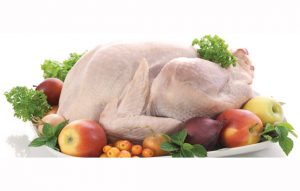 There are plenty of decisions to make when purchasing your Thanksgiving turkey. Turkeys to be sold fresh are quick-chilled to 40°F or lower at the processing facility, but must not go below a temperature of 26°F. You may think that turkeys chilled to this temperature would be ‘frozen’, but they aren’t. The low temperature helps to retain quality at the market and in your home refrigerator. The noted advantage of a fresh turkey is that you skip the thawing step; the 4-5 days when the turkey is taking up room in your refrigerator. If you purchase a fresh turkey, keep it refrigerated and cook within 1 to 2 days from purchase.
There are plenty of decisions to make when purchasing your Thanksgiving turkey. Turkeys to be sold fresh are quick-chilled to 40°F or lower at the processing facility, but must not go below a temperature of 26°F. You may think that turkeys chilled to this temperature would be ‘frozen’, but they aren’t. The low temperature helps to retain quality at the market and in your home refrigerator. The noted advantage of a fresh turkey is that you skip the thawing step; the 4-5 days when the turkey is taking up room in your refrigerator. If you purchase a fresh turkey, keep it refrigerated and cook within 1 to 2 days from purchase.
Most turkey are sold frozen. At the processing plant, a commercial blast freezer quickly takes the turkey to a freezing temperature, ensuring optimum safety and quality. They are then stored in freezers at 0°F or below. Thawing a frozen turkey may take 4-5 days in the refrigerator. If you want to purchase a pre-stuffed turkey, the USDA states that it should be purchased frozen, not fresh. The USDA notes that, “Frozen pre-stuffed turkeys are safe because they have been processed under controlled conditions.” Further, the USDA instructs consumers not to thaw pre-stuffed turkeys before cooking, but to cook them from the frozen state.
Either fresh or frozen, allow 1 pound of turkey per person.
Here are a few other options you have for your Thanksgiving bird:
- The term ‘natural’ on a turkey label indicates that the product does not contain any artificial flavor or flavoring, coloring ingredients, chemical preservative, or any other artificial or synthetic ingredient. Natural is not a synonym for ‘organic’ or ‘healthy.’
- Self-basting turkeys. These birds are are injected or marinated with a solution designed to help keep the meat juicy and flavorful. The basting solution usually contains butter or other edible fat, broth, stock, or water, plus spices, flavor enhancers, and other approved substances. Labels must include a statement identifying the total quantity and common or usual name of all ingredients in the solution, e.g., “Injected with approximately 3% of a solution of _____________ (list of ingredients).”
- Free range or free roaming terms on a label imply that the birds had continuous, free access to the out-of-door for over 51% of their lives.
- Turkeys can also be labeled with terms such as fryer-roaster (a young turkey, usually less than 16 weeks of age); hen (a female turkey); or tom (a male turkey). The terms ‘hen’ and ‘tom’ are an indication of size rather than tenderness, with tom turkeys generally larger than hens.
- Kosher labels can be used only for turkeys that are prepared under Rabbinical supervision.
- Turkeys labeled with the USDA organic seal are raised on a farm that complies with the USDA Organic Standards and are processed in a facility that also meets certain standards.
Our next topic: Brining safely will bring tender, flavorful meat to the Thanksgiving table. Stay food-safe! Barb




